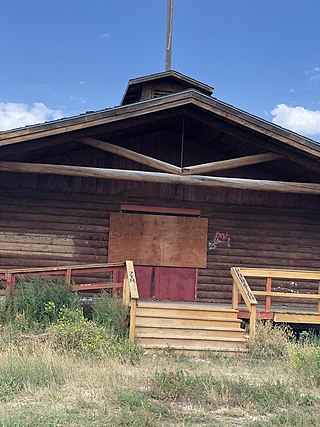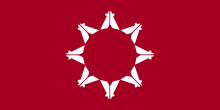
Porcupine is a census-designated place (CDP) in Oglala Lakota County, South Dakota, United States. The population was 925 at the 2020 census.

The American Indian Movement (AIM) is an American Indian grassroots movement which was founded in Minneapolis, Minnesota in July 1968, initially centered in urban areas in order to address systemic issues of poverty, discrimination, and police brutality against American Indians. AIM soon widened its focus from urban issues to many Indigenous Tribal issues that American Indian groups have faced due to settler colonialism in the Americas. These issues have included treaty rights, high rates of unemployment, the lack of American Indian subjects in education, and the preservation of Indigenous cultures.

The Pine Ridge Indian Reservation, also called Pine Ridge Agency, is an Oglala Lakota Indian reservation located in the U.S. state of South Dakota, with a small portion of it extending into Nebraska. Originally included within the territory of the Great Sioux Reservation, Pine Ridge was created by the Act of March 2, 1889, 25 Stat. 888. in the southwest corner of South Dakota on the Nebraska border. It consists of 3,468.85 sq mi (8,984 km2) of land area and is one of the largest reservations in the United States.

Whiteclay is a census-designated place in Sheridan County, Nebraska, United States. The population was 10 at the 2010 census.

Russell Charles Means was an Oglala Lakota activist for the rights of Native Americans, libertarian political activist, actor, musician and writer. He became a prominent member of the American Indian Movement (AIM) after joining the organization in 1968 and helped organize notable events that attracted national and international media coverage.

Frank Fools Crow was an Oglala Lakota civic and religious leader. 'Grandfather', or 'Grandpa Frank' as he was often called, was a nephew of Black Elk who worked to preserve Lakota traditions, including the Sun Dance and yuwipi ceremonies. He supported Lakota sovereignty and treaty rights, and was a leader of the traditional faction during the armed standoff at Wounded Knee in 1973. With writer Thomas E. Mails, he produced two books about his life and work, Fools Crow in 1979, and Fools Crow: Wisdom and Power in 1990.
Cecilia Fire Thunder is a nurse, community health planner and tribal leader of the Oglala Sioux. On November 2, 2004, she was the first woman elected as president of the Tribe. She served until being impeached on June 29, 2006, several months short of the two-year term. The major controversy was over her effort to build a Planned Parenthood clinic on the reservation after the South Dakota legislature banned most abortions throughout the state. The tribal council impeached her for proceeding without gaining their consensus.

The Wounded Knee Occupation, also known as Second Wounded Knee, began on February 27, 1973, when approximately 200 Oglala Lakota and followers of the American Indian Movement (AIM) seized and occupied the town of Wounded Knee, South Dakota, United States, on the Pine Ridge Indian Reservation. The protest followed the failure of an effort of the Oglala Sioux Civil Rights Organization (OSCRO) to use impeachment to remove tribal president Richard Wilson, whom they accused of corruption and abuse of opponents. Additionally, protesters criticized the United States government's failure to fulfill treaties with Native American people and demanded the reopening of treaty negotiations to hopefully arrive at fair and equitable treatment of Native Americans.
Richard A. Wilson was elected chairman of the Oglala Lakota of the Pine Ridge Indian Reservation in South Dakota, where he served from 1972–1976, following re-election in 1974.

Incident at Oglala is a 1992 American documentary film directed by Michael Apted and narrated by Robert Redford. The film documents the deaths of two Federal Bureau of Investigation agents, Jack R. Coler and Ronald A. Williams, on the Pine Ridge Indian Reservation on June 26, 1975. Also killed in the multiple fire was Native American Joe Stuntz, a member of the American Indian Movement (AIM), whose death prompted no legal action.

The Red Power movement was a social movement led by Native American youth to demand self-determination for Native Americans in the United States. Organizations that were part of the Red Power Movement include the American Indian Movement (AIM) and the National Indian Youth Council (NIYC). This movement sought the rights for Native Americans to make policies and programs for themselves while maintaining and controlling their own land and resources. The Red Power movement took a confrontational and civil disobedience approach to inciting change in United States to Native American affairs compared to using negotiations and settlements, which national Native American groups such as National Congress of American Indians had before. Red Power centered around mass action, militant action, and unified action.

The Oglala are one of the seven subtribes of the Lakota people who, along with the Dakota, make up the Očhéthi Šakówiŋ. A majority of the Oglala live on the Pine Ridge Indian Reservation in South Dakota, the eighth-largest Native American reservation in the United States.

Skins is a 2002 American feature film by Chris Eyre and based upon the novel of the same name by Adrian C. Louis. It was filmed on South Dakota's Pine Ridge Indian Reservation, which served as the setting in the novel. Lakota Sioux tribal police officer Rudy Yellow Lodge struggles to rescue his older, alcoholic brother, Mogie, a former football star who was wounded in combat three times in Vietnam. Winona LaDuke makes a cameo appearance as Rose Two Buffalo.
Timothy Antoine Giago Jr., also known as Nanwica Kciji, was an American Oglala Lakota journalist and publisher. In 1981, he founded the Lakota Times with Doris Giago at the Pine Ridge Indian Reservation, where he was born and grew up. It was the first independently owned Native American newspaper in the United States. In 1991 Giago was selected as a Nieman Fellow at Harvard University. In 1992 he changed his paper's name to Indian Country Today, to reflect its national coverage of Indian news and issues.
Theresa B. "Huck" Two Bulls was an attorney, prosecutor and politician in the United States and the Oglala Sioux Tribe. In 2004 she was elected as Democratic member of the South Dakota Senate, representing the 27th district, the first American Indian woman to be elected to the state legislature. She served until 2008. That year Two Bulls was elected as president of the Oglala Sioux Tribe of the Pine Ridge Reservation, the second woman to serve in this position. She served one term, which was two years.
Leonard Crow Dog was a medicine man and spiritual leader who became well known during the Lakota takeover of the town of Wounded Knee on the Pine Ridge Indian Reservation in South Dakota in 1973, known as the Wounded Knee Incident. Through his writings and teachings, he has sought to unify Indian people of all nations. As a practitioner of traditional herbal medicine and a leader of Sun Dance ceremonies, Crow Dog was also dedicated to keeping Lakota traditions alive.
Gladys Bissonette, "the brave–hearted woman of Wounded Knee", was an Oglala Lakota elder who was one of the leaders of the traditional faction during the violent turmoil on the Pine Ridge Indian Reservation during the 1970s. Dick Wilson became Tribal Chairman in 1972 and began a "reign of terror" on the reservation. Wilson favored mixed–blood residents and close family and friends for positions in his office and created a special enforcing unit, known as the "Goon Squad", to police the region. This Goon Squad soon began to terrorize the residents of the reservation who openly spoke out against Wilson or disagreed with him, especially those who were pure–blooded Indians. Many attempts were made at impeaching Wilson, but Wilson always interfered and subsequently kept his position by sending out his Goon Squad to stamp out the residents who dared try to impeach him. "The past administrations all along have been pretty sly and crooked with Indian funds," said Gladys, "but they weren't quite as hard on us as this drunken fool we got now."
Edgar Donroy Bear Runner was a Native American activist. He is perhaps best known for attempting to peacefully negotiate the Jumping Bull ranch incident in 1975 via parleying with American Indian Movement activists.

John Yellow Bird Steele is an American politician. He was the President of the Oglala Sioux Tribe for 14 years. Akim Reinhardt described him as "arguably the most successful Pine Ridge politician of the IRA era".
Ellen Moves Camp was an Oglala woman who played a critical role in activism for Indians in America. Her name became known when Dick Wilson, a chairman elected to oversee their reservation, started heavily persecuting the Native Americans that lived there. Moves Camp and other full-blood elders started to rally their peers and supporting groups such as the American Indian Movement (AIM) to stand up against the government. After further oppression, they met at Calico hall where multiple older women including Moves Camp urged the men to act, and planned a siege at Wounded Knee known as the Wounded Knee Occupation. This siege drew a lot of public attention, and through it, those at Pine Ridge were able to receive funding and support throughout trials and movements made from then on. Moves Camp died in 2008 at the Pine Ridge reservation after dedicating years of her life to raising awareness for her people and instilling movement into those around her.











